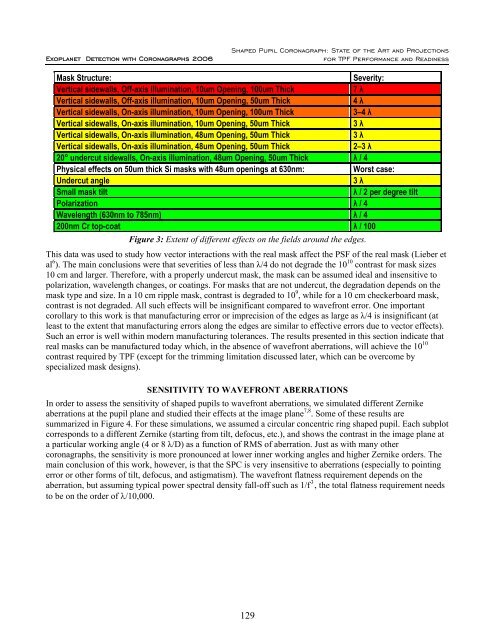Shaped Pupil Coronagraph: State of the Art and Projections for TPF ...
Shaped Pupil Coronagraph: State of the Art and Projections for TPF ...
Shaped Pupil Coronagraph: State of the Art and Projections for TPF ...
You also want an ePaper? Increase the reach of your titles
YUMPU automatically turns print PDFs into web optimized ePapers that Google loves.
Exoplanet Detection with <strong>Coronagraph</strong>s 2006<strong>Shaped</strong> <strong>Pupil</strong> <strong>Coronagraph</strong>: <strong>State</strong> <strong>of</strong> <strong>the</strong> <strong>Art</strong> <strong>and</strong> <strong>Projections</strong><strong>for</strong> <strong>TPF</strong> Per<strong>for</strong>mance <strong>and</strong> ReadinessMask Structure:Severity:Vertical sidewalls, Off-axis illumination, 10um Opening, 100um Thick7 λVertical sidewalls, Off-axis illumination, 10um Opening, 50um Thick4 λVertical sidewalls, On-axis illumination, 10um Opening, 100um Thick3–4 λVertical sidewalls, On-axis illumination, 10um Opening, 50um Thick3 λVertical sidewalls, On-axis illumination, 48um Opening, 50um Thick3 λVertical sidewalls, On-axis illumination, 48um Opening, 50um Thick2–3 λ20° undercut sidewalls, On-axis illumination, 48um Opening, 50um Thick λ / 4Physical effects on 50um thick Si masks with 48um openings at 630nm:Worst case:Undercut angle3 λSmall mask tiltλ / 2 per degree tiltPolarization λ / 4Wavelength (630nm to 785nm) λ / 4200nm Cr top-coat λ / 100Figure 3: Extent <strong>of</strong> different effects on <strong>the</strong> fields around <strong>the</strong> edges.This data was used to study how vector interactions with <strong>the</strong> real mask affect <strong>the</strong> PSF <strong>of</strong> <strong>the</strong> real mask (Lieber etal 6 ). The main conclusions were that severities <strong>of</strong> less than λ/4 do not degrade <strong>the</strong> 10 10 contrast <strong>for</strong> mask sizes10 cm <strong>and</strong> larger. There<strong>for</strong>e, with a properly undercut mask, <strong>the</strong> mask can be assumed ideal <strong>and</strong> insensitive topolarization, wavelength changes, or coatings. For masks that are not undercut, <strong>the</strong> degradation depends on <strong>the</strong>mask type <strong>and</strong> size. In a 10 cm ripple mask, contrast is degraded to 10 9 , while <strong>for</strong> a 10 cm checkerboard mask,contrast is not degraded. All such effects will be insignificant compared to wavefront error. One importantcorollary to this work is that manufacturing error or imprecision <strong>of</strong> <strong>the</strong> edges as large as λ/4 is insignificant (atleast to <strong>the</strong> extent that manufacturing errors along <strong>the</strong> edges are similar to effective errors due to vector effects).Such an error is well within modern manufacturing tolerances. The results presented in this section indicate thatreal masks can be manufactured today which, in <strong>the</strong> absence <strong>of</strong> wavefront aberrations, will achieve <strong>the</strong> 10 10contrast required by <strong>TPF</strong> (except <strong>for</strong> <strong>the</strong> trimming limitation discussed later, which can be overcome byspecialized mask designs).SENSITIVITY TO WAVEFRONT ABERRATIONSIn order to assess <strong>the</strong> sensitivity <strong>of</strong> shaped pupils to wavefront aberrations, we simulated different Zernikeaberrations at <strong>the</strong> pupil plane <strong>and</strong> studied <strong>the</strong>ir effects at <strong>the</strong> image plane 7,8 . Some <strong>of</strong> <strong>the</strong>se results aresummarized in Figure 4. For <strong>the</strong>se simulations, we assumed a circular concentric ring shaped pupil. Each subplotcorresponds to a different Zernike (starting from tilt, defocus, etc.), <strong>and</strong> shows <strong>the</strong> contrast in <strong>the</strong> image plane ata particular working angle (4 or 8 λ/D) as a function <strong>of</strong> RMS <strong>of</strong> aberration. Just as with many o<strong>the</strong>rcoronagraphs, <strong>the</strong> sensitivity is more pronounced at lower inner working angles <strong>and</strong> higher Zernike orders. Themain conclusion <strong>of</strong> this work, however, is that <strong>the</strong> SPC is very insensitive to aberrations (especially to pointingerror or o<strong>the</strong>r <strong>for</strong>ms <strong>of</strong> tilt, defocus, <strong>and</strong> astigmatism). The wavefront flatness requirement depends on <strong>the</strong>aberration, but assuming typical power spectral density fall-<strong>of</strong>f such as 1/f 3 , <strong>the</strong> total flatness requirement needsto be on <strong>the</strong> order <strong>of</strong> λ/10,000.129
















